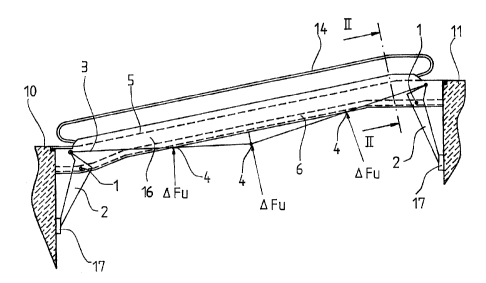Some of the information on this Web page has been provided by external sources. The Government of Canada is not responsible for the accuracy, reliability or currency of the information supplied by external sources. Users wishing to rely upon this information should consult directly with the source of the information. Content provided by external sources is not subject to official languages, privacy and accessibility requirements.
Any discrepancies in the text and image of the Claims and Abstract are due to differing posting times. Text of the Claims and Abstract are posted:
| (12) Patent: | (11) CA 2390783 |
|---|---|
| (54) English Title: | ESCALATOR OR MOVING WALKWAY WITH SUPPORT STRUCTURE |
| (54) French Title: | ESCALIER MECANIQUE OU TROTTOIR MECANIQUE AVEC STRUCTURE SUPPORT |
| Status: | Deemed expired |
| (51) International Patent Classification (IPC): |
|
|---|---|
| (72) Inventors : |
|
| (73) Owners : |
|
| (71) Applicants : |
|
| (74) Agent: | RICHES, MCKENZIE & HERBERT LLP |
| (74) Associate agent: | |
| (45) Issued: | 2009-12-29 |
| (22) Filed Date: | 2002-06-14 |
| (41) Open to Public Inspection: | 2003-01-02 |
| Examination requested: | 2007-04-11 |
| Availability of licence: | N/A |
| (25) Language of filing: | English |
| Patent Cooperation Treaty (PCT): | No |
|---|
| (30) Application Priority Data: | ||||||
|---|---|---|---|---|---|---|
|
The escalator or moving walkway has at both sides a respective support structure (16) supported between the rests at a cable (3), which is arranged laterally or below the support structure (16). According to the invention there is provided in the region of each rest a respective lever (2) which is rotatably mounted at the support structure (16) and is slidingly supported by one arm at the building structure, the cable (3) being fastened to the other arm of the lever so that the cable (3) is additionally tensioned when the support structure (16) bends. In this manner, the construction is very stiff so that the escalator bends only slightly even under heaving loading.
Un escalier mécanique ou un trottoir roulant comporte, sur les deux côtés, une structure de support respective (16) appuyée entre les affûts au niveau d'un câble (3), qui est disposé latéralement ou au-dessous de la structure de support (16). Selon l'invention, on prévoit dans la zone de chaque affût un levier respectif (2) qui est monté de manière rotative sur la structure de support (16) et est supporté de manière coulissante par un bras au niveau de la structure de bâtiment, le câble (3) étant fixé à l'autre bras du levier de sorte que le câble (3) soit davantage tendu lorsque la structure de support (16) se plie. De cette manière, la construction est très rigide, si bien que l'escalier roulant se courbe seulement légèrement, même sous une charge élevée.
Note: Claims are shown in the official language in which they were submitted.
Note: Descriptions are shown in the official language in which they were submitted.

For a clearer understanding of the status of the application/patent presented on this page, the site Disclaimer , as well as the definitions for Patent , Administrative Status , Maintenance Fee and Payment History should be consulted.
| Title | Date |
|---|---|
| Forecasted Issue Date | 2009-12-29 |
| (22) Filed | 2002-06-14 |
| (41) Open to Public Inspection | 2003-01-02 |
| Examination Requested | 2007-04-11 |
| (45) Issued | 2009-12-29 |
| Deemed Expired | 2017-06-14 |
There is no abandonment history.
| Fee Type | Anniversary Year | Due Date | Amount Paid | Paid Date |
|---|---|---|---|---|
| Registration of a document - section 124 | $100.00 | 2002-06-14 | ||
| Application Fee | $300.00 | 2002-06-14 | ||
| Maintenance Fee - Application - New Act | 2 | 2004-06-14 | $100.00 | 2004-05-21 |
| Maintenance Fee - Application - New Act | 3 | 2005-06-14 | $100.00 | 2005-05-30 |
| Maintenance Fee - Application - New Act | 4 | 2006-06-14 | $100.00 | 2006-05-29 |
| Request for Examination | $800.00 | 2007-04-11 | ||
| Maintenance Fee - Application - New Act | 5 | 2007-06-14 | $200.00 | 2007-05-30 |
| Maintenance Fee - Application - New Act | 6 | 2008-06-16 | $200.00 | 2008-05-26 |
| Maintenance Fee - Application - New Act | 7 | 2009-06-15 | $200.00 | 2009-05-28 |
| Final Fee | $300.00 | 2009-10-15 | ||
| Maintenance Fee - Patent - New Act | 8 | 2010-06-14 | $200.00 | 2010-06-03 |
| Maintenance Fee - Patent - New Act | 9 | 2011-06-14 | $200.00 | 2011-06-01 |
| Maintenance Fee - Patent - New Act | 10 | 2012-06-14 | $250.00 | 2012-05-31 |
| Maintenance Fee - Patent - New Act | 11 | 2013-06-14 | $250.00 | 2013-06-03 |
| Maintenance Fee - Patent - New Act | 12 | 2014-06-16 | $250.00 | 2014-06-02 |
| Maintenance Fee - Patent - New Act | 13 | 2015-06-15 | $250.00 | 2015-06-01 |
Note: Records showing the ownership history in alphabetical order.
| Current Owners on Record |
|---|
| INVENTIO AG |
| Past Owners on Record |
|---|
| KRAMPL, DAVID |